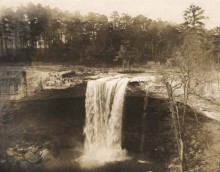This story can also be found in the book Alabama Footprints: Immigrants
Routes Taken To The Alabama Territory
After the Creek cession, the first lands in Alabama were put on sale at Milledgeville, Georgia and lay along the upper course of the Alabama River in the neighborhood of present-day Montgomery County. This is why there is a predominance of Georgians in this area.
The location where immigrants settled in the Alabama region usually depended on the state he was from and the route he traveled. A man coming from the piedmont region of Georgia could choose between two routes:
- The Federal Road which followed the Alabama-Tombigbee basin.
- Another road which passed from Augusta to Athens crossed the Tennessee River to Chattanooga and on to Nashville. This highway then crossed the road from Knoxville to Huntsville and gave access to the Tennessee Valley.
Early Georgia immigrants who settled in Madison County took the 2nd route while later planters from Georgia took the Federal Road and settled in the southern part of Alabama.
Immigrants from South Carolina also had two routes available to them.
- The fall-line road through Columbia, South Carolina.
- The piedmont road through Greenville and reach the Alabama basin by the Federal Road.
To reach the Tennessee Valley, the South Carolina immigrants passed northward from Greenville, through Saluda Gap in the Blue Ridge where it borders North and South Carolinian, then on to the site of Asheville, and along the course of the French Broad to Knoxville, then on to Huntsville, Alabama. They seemed to have traveled both routes and the majority of them passed on to the central hilly region or the basin of the Black Warrior and upper Tombigbee Rivers.
North Carolina immigrants, like South Carolina immigrants, seemed to favor the central region of Alabama. They also followed two routes:
- The route along the French Broad to Knoxville, and onward to Huntsville.
- The route from Raleigh through Columbus and Augusta to the Federal Road.
Virginians routes depended on where they lived in Virginia.
- The Virginians who came from the Valley followed the route through Cumberland Gap and down the Holston to Knoxville and the Tennessee Valley.
- The Virginians from the piedmont region probably took one of the eastern roads leading to southern Alabama and made their way into the Tombigbee-Warrior region.
Tennesseans had the easiest journey. They only had to travel over the Tennessee line and many became squatters in North Alabama.
“The principal route of travel connecting the Tennessee Valley with the Alabama-Tombigbee region was a road passing southwestward from Huntsville through Jones Valley to the town of Tuscaloosa, which grew up at the head of boat navigation upon the Black Warrior. It was along this route that the principal settlements were made in the central hilly region.“
At first, the Tennesseans predominated here, but South Carolinians soon came in so numerously as to outnumber the Tennesseans in some localities. The struggle for supremacy between these elements in Blount and Jefferson Counties provoked open hostilities before it was settled. Finally, the Tennesseans came to predominate in Blount, while the South Carolinians had the majority in Jefferson County.”1
“In the Tombigbee-Warrior region, North Carolinians, South Carolinians, and Virginians mingled in varying proportions but together formed a predominating population element which had its own characteristics. As late as 1856, Greene County, Alabama at the conjunction of the Black Warrior with the Tombigbee, had a population of 438 native South Carolinians, 357 Alabamians, 348 North Carolinians, 92 Georgians, 45 Tennesseans, 24 Kentuckians, 12 men from Connecticut, 37 from Ireland, and 10 from Germany.”
“The presence of a small number of foreigners is characteristic of the early period, and so is the presence of New Englanders. The cosmopolitan population was confined to the trading towns where the merchants were largely Yankees. This was especially true of Mobile, where the transient population was turbulent and varied. A community of Germans was established at Dutch Bend on the Alabama River; and Demopolis, on the Tombigbee, was founded by a band of Napoleonic refugees. However, such segregated community-building was not characteristic.”2
“Finally, in spite of the mixture which was produced by the flow of immigration into Alabama, three areas can be distinguished which show peculiarities due partly to the predominant element in the population. In the Tennessee Valley the preponderance of Tennesseans gave a strongly democratic flavor to political ideas; in the Tombigbee-Warrior region, the Carolina-Virginia predominance seems to be indicated by a flavor of conservatism in things political; while the influence of Georgia politics is clearly discernible in Montgomery County. However, there are other factors which played a more important part in shaping opinions and politics than did the origin of the population, the effect of which, indeed, is often entirely obliterated.”3
1Abernethy, Thomas Perkins, The Formative Period in Alabama 1815-1828, Issue 6, 1922
2Abernethy, Thomas Perkins, The Formative Period in Alabama 1815-1828, Issue 6, 1922
3Abernethy, Thomas Perkins, The Formative Period in Alabama 1815-1828, Issue 6, 1922
ALABAMA FOOTPRINTS Immigrants: Lost & Forgotten Stories (Volume 5)
ALABAMA FOOTPRINTS Immigrants includes some lost & forgotten stories of their experiences such as:
- The Birth of Twickenham
- Captain Slick – Fact or Fiction
- Vine & Olive Company
- The Death of Stooka
- President Monroe’s Surprise Visit To Huntsville






This is a great read